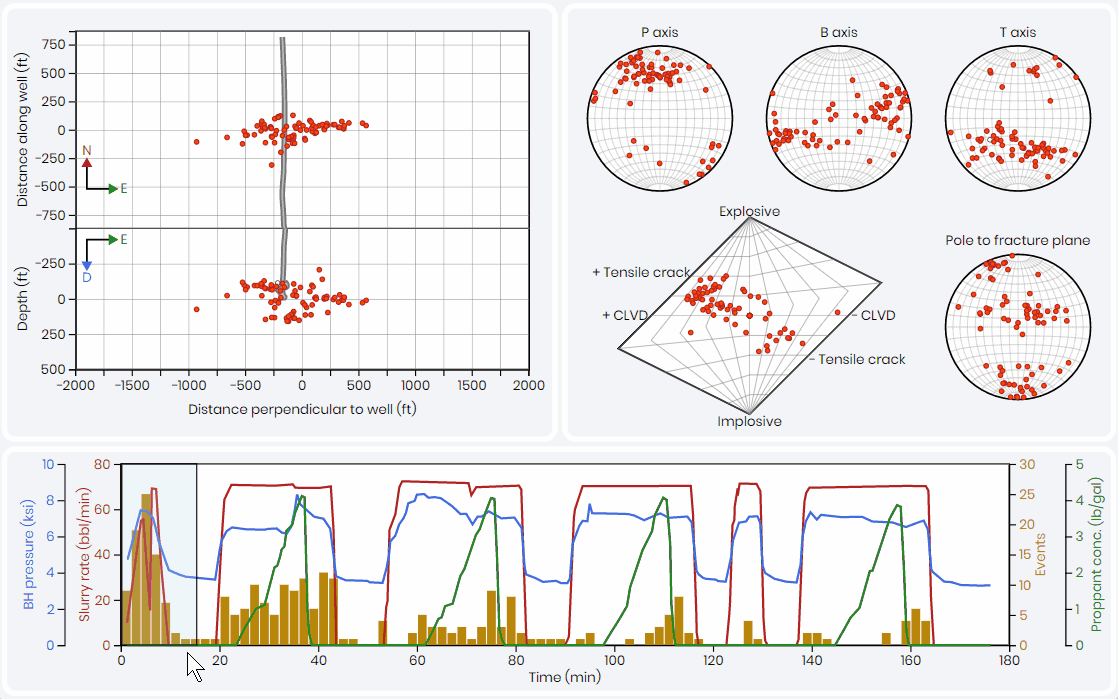Like any industrial monitoring technology, the success of microseismic monitoring in the context of hydraulic fracturing is directly tied to the ability to affect operational decisions. For hydraulic fracturing, the concerns usually come down to determining how big the area that has been effectively stimulated is and where in the reservoir the production will come from.
Let’s start with some fundamentals. Hydraulic fracturing is accomplished through initiating a weakness point (or several) around a well. One approach commonly used is through the use of a perforation gun, and then pumping high pressure fluids and particulates (proppant) though the well at these entry points (commonly referred to as perfs or perf zones) extend into hydraulic fractures away from the treatment well. These hydraulic fractures will interact with the pre-existing network or fractures in the medium, and will generate a slip on these fractures. The zone of “influence” of the stimulation can be potentially outlined based on the observed fracturing that occurs under dynamic stress conditions.
Stimulated Reservoir Volume (SRV)
If the SRV can be estimated accurately from microseismicity, then the operators can predict how much hydrocarbon they may produce with time and gain accurate estimates of Net Present Value (NPV) after hydraulic fracturing. Other information form other data streams are integrated with the estimated SRV at this step. Beyond the economics of the production size, understanding how far away from the well primary production may be expected, and along what azimuth, informs an operator on how to drill their child wells to complete their asset.
The Holy Grail
A production engineer will usually assume that primary production (that is, the early production that comes through the well with the highest rate) is dominated by the cracks that have received proppant, so called “propped volume.” The “holy grail” of microseismic monitoring of hydraulic fractures is therefore to determine which events represent fractures that will receive proppant from the other cloud of events. While mapping proppant distribution is a lofty aspiration, a useful lower-hanging fruit is to determine events that are showing more connectivity in close proximity to the treatment well, which are more likely fluid influenced fractures versus other that are stress induced. By focusing on these fluid-connected areas, plausible volumes of production can be obtained, resulting in better estimates for SRV.

Above 👆 is the “Completion Evaluator” simulation hosted on the metaKinetic platform. Using this application you can explore activated fractures identified through microseismic distribution, and examine inferred modes of failure and dynamics of stress/strain field, and witness their relationship to treatment parameters such as pressure, slurry rate, and proppant concentration.
Beyond Accurate SRV Estimates
Fracturing and stress behavior are paramount to understanding the effectiveness of stimulation programs. As differences in injection rates, pressure, and fluid and proppant types occur during a stimulation, the rock fracturing response is directly related to the dynamic stress conditions that make it ideal for different fracture sets to be activated. Tracking fracture orientations, failure types, and localized stress orientations provides the impetus for defining the roles of different injection parameters.
The microseismic response of different treatments may be used to understand how to effectively stimulate a reservoir, and adjust the stimulation parameters based on the reservoir response. Further to the optimization of stimulation parameters, optimally all the fluid and proppant will be contained within “zone”, the targeted hydrocarbon-bearing lithological formation. Sparse events out of zone are often not indicative of fractures that are connected to producing region.
Microseismicity, if well located and characterized, can outline the effectively stimulated regions, and can therefore be used to adjust the stimulations to avoid out-of-zone growth. The discrimination of regions that have not been effectively stimulated within zones of stimulation – the so-called “bypass” zones – can be identified as areas of relative quiescence. Once identified, these regions can be targeted with further development of the asset.
Ted Urbancic, Scientific Advisor
Want access to this simulation and more on the metaKinetic platform? Contact us!
